The battle
90th Infantry Division “Tough' Ombres”
Organisation
- Reconnaissance
90th reconnaissance Troop - Infantry
357th infantry regiment
358th infantry regiment
359th infantry regiment - Artillery
343rd field artillery battalion
344th field artillery battalion
345th field artillery battalion
915th field artillery battalion - Special troops
90th signal company
790th ordnance company
90th quartermaster company
315th engineers battalion
315th medical battalion
90th CIC detachment
History
90th infantry division take its roots from the homonymous unit which had been fighting during the First World War. Created in August 1917, it was sent to France in June 1918. It was quickly engaged on the front of Argonne, and took part in the offensives of the autumn. During these battles, the 90th ID suffered heavy losses at Saint-Mihiel, before going back to the United States and being finally dissolved in 1919.
On March 25, 1942, the 90th ID was recreated in Camp Barkeley. Mainly composed of recruits from Texas and Oklahoma, division adopted for its blazon the letters T and O tangled up, which gave its nickname - Tough Hombres. Division participated at the beginning of 1943 to the operations in Louisiana, then turned over to Camp Barkeley to improve in street battle. In September, it took part in the manoeuvres of the California desert. In March 1944, 90th ID was sent to Great Britain, where, awaiting for D-day, it finished its training.
Battle of Normandy
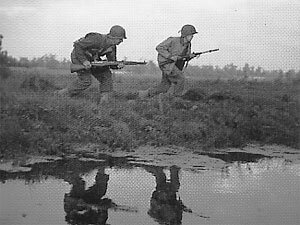 July 14th, 1944 - two “Tough Hombres” progress towards the Sèves.
July 14th, 1944 - two “Tough Hombres” progress towards the Sèves.
In front of them awaits PzD Das Reich, firmly entrenched.
The first units of the 90th infantry division were attached to the 4th ID and landed on Utah beach in the morning of D-Day. The remainder of division on June 8th followed them. 90th ID was attached to the 7th Corps and on June 10th, it was committed on Merderet in direction of Pont-L'Abbé. Its advance was tiny - Gen. Landrum captured Amfreville only after 6 days of heavy fighting - and provoked the removal of 90th ID commander, Gen. MacKelvie.
From June 14th, Texas-Oklahoma Division occupied defensive positions close to Valognes, opening the way for the 9th ID which could this way cut the Cotentin Peninsula. Attached to the 8th Corps, it was then launched in the attack towards the south, in the hell of the war of the hedgerows. Pretot, Saint-Jores, La Butte or Beau-Coudray was conquered at the price of blood. July 10th, 358th regiment managed to seize Mount Castres, and continued the offensive. July 14th, after an ambush had cost it over 200 prisoners, 90th ID stopped on the Sèves.
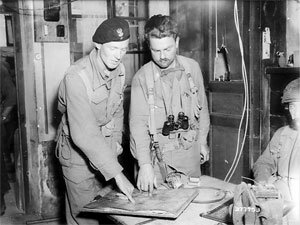 August 1944 - Major Leonard Dull (359th Regiment) and Lt. Klaptocz
August 1944 - Major Leonard Dull (359th Regiment) and Lt. Klaptocz
(10th Dragoons) study the map during the fighting in Chambois.
CR Basse-Normandie / National Archives USA
With the launching of the operation Cobra, 90th ID resumed its offensive. It seized Périers on July 27th, followed the next day by Saint-Sauveur-Lendelin. After a three days rest, 90th ID was attached to the 3rd Army (gen. Patton) and was redirected towards the east. On August 3rd, it liberated Saint-Hilaire-du-Harcouët, then Landivy. August 5th, after a short fight, it seized a bridge on Mayenne. It passed the Sarthe north of Le Mans the 10th, then followed to the north the progression of the 2nd Free French Armored Division, through the forest of Gouffern.
From August 15th, 359th regiment leading, Tough Hombres positioned between Sées and Bourg-Saint-Léonard, but were immobilised by violent counter-attacks which prevented them from progressing towards Fel. It is only August 19th, in the evening, that 2/359th managed to reach the Poles of 10th dragoons in Chambois, closing the Falaise pocket. For two days, Tough Hombres and polish Dragoons, reinforced by Sherman tanks of 24th Lancers, resisted the desperate attacks of the Germans, sealing the fate of 7th German Army. The battle of Chambois marked the end of the German presence in Normandy.
Campaign of Lorraine
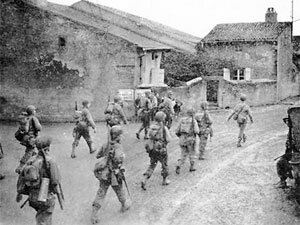 September 1944 – 90th ID advances towards Metz.
September 1944 – 90th ID advances towards Metz.
Having played a foreground role in the last stages of the battle of Normandy, 90th ID was attached to the 20th Corps. From August 26th, it returned to Patton’s 3rd Army and chased the German army, which was fleeing from France. On its road, it liberated Fontainebleau, Chateau-Thierry, then Rheims. At the beginning of September, it slowed down its advance, as the supply was not able to follow.
In the aim of the attack against Metz, 90th ID was moved on Etain. It launched its attack September 7th, on the left flank of the 7th AD, before being surprised by a night encounter with 106 Pz-Brigade in Mairy. However, despite confusion, Tough Hombres managed to maul it badly in a night fight. Until the 12th, fighting continued as 90th ID battled its way to Thionville. Patrolling the sector north of Metz, it approached the external fortification ring. An attack was launched on October 7th against Maizières-lès-Metz but the Germans managed to keep control of main part of the city. Maizières remained divided between the two opponents until October 28th, date on which the Division captured its ruins.
Moved more north, 90th Infantry was charged to cross the Moselle. It succeeds in establishing a bridgehead over the flooding river. In spite of increasing losses, it managed at the end of a three days attack to capture Koenigsmacher fortress. November 12th, 359th regiment pushed back a strong counter-attack of the 24. PzGrD, before being finally helped by tanks. Progressing towards the south, division finished to clean the Hackenberg fortifications and met on November 19th advanced elements of the 5th ID, closing the pincer on Metz.
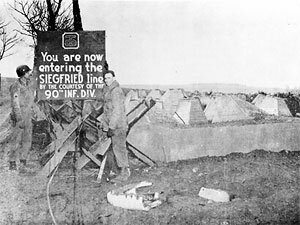 February 1945 - the Siegfried line is crossed for the second time.
February 1945 - the Siegfried line is crossed for the second time.
From November 23rd on, 90th ID was directed on the Saar. Overcoming German defences, its first patrols managed to reach the river on November 29th. On December 6th, it succeeded in crossing and establishing on northern bank. It breached defences of the Siegfried line and arrived at Dillingen, but the start of the German counter-offensive in the Ardennes obliged it to withdraw back to France. It would occupy its defensive positions on left bank of Saar until January 1945.
Fighting in Germany
On January 5th, 90th ID was transferred to Luxembourg to take part in the reduction of the Ardennes salient. January 9th, it attacked between Bavigne and Nothum and progressed towards Niederwampach, but faced an armoured counter-attack. It battled to secure accesses to the Our, which marked the German border.
The crossing of Our River took place on January 29th, 1945, around Oberhausen. Once on opposite bank, Tough Hombres tackled Habscheid then, on February 6th, they launched a new attack on the Siegfried line. After four days of engagements, the fortifications had been broken, and 90th ID captured Prüm January 12th. German resistance weakened, while the progression of 90th ID accelerated. In spite of its failure to seize a bridge at Waxweiler, the division cleaned the banks of Prüm. On February 24th, it was placed in reserve.
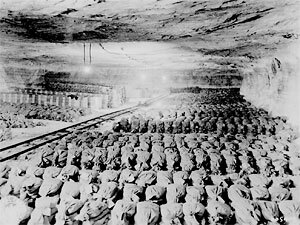 April 1945 - Treasury stored in the salt mine of Merkers
April 1945 - Treasury stored in the salt mine of Merkers
Tough' Hombres set out again with the attack on March 3rd. They established a bridge on Prüm, then advanced until Kyll, reached two days later and immediately crossed. They progressed then quickly towards the east - the capture of Waldkonigen will however cost a full day of fight.
On March 10th, 90th ID was attached to the 12th Corps and was ordered to carry a new crossing of the Moselle. This operation was concluded March 14th between Löf and Katennes, but 90th ID was engaged by the 6. SS-Gebirgs Division which opposed strong resistance. In spite of this hitch, it arrived at the Rhine in the neighbourhood of Boppard, then moved towards Mainz. After some combat in the suburbs, it captured the city on March 22nd.
Having captured Mainz, 90th ID immediately started to cross the Rhine. The following day, it captured Darmstadt, before moving on the Main. This river was crossed March 28th and 90th ID moved east. It crossed the Werra on April 2nd. In Merkers, it discovered an incredible treasure hidden in a salt mine - 100 tons of gold, 5 billion Deutsche Marks, 100 million French Francs, 4 millions Norwegian Pounds, 2 million Dollars, and more than 100.000 Pounds. Moreover, more than 1.000 cases of artworks were discovered. A whole regiment was detached to keep the mine…
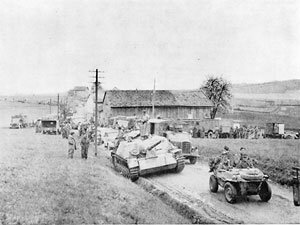 May 4th, 1945 - 11. PzD surrenders
May 4th, 1945 - 11. PzD surrenders
Resuming again its race, 90th ID crossed Thuringia, then obliqued southeast towards Czechoslovakia. After having captured Hof, it was on April 18th the first allied division to penetrate there. April 23rd, it liberated the concentration camp of Flossenberg and the 1.500 prisoners who had not been evacuated by the SS.
At the beginning of May, it still had to fight to take control of Vseruby. May 4th, it received the capitulation of 11. PzD. it was moving on the Czechoslovakian capital when it got informed of german capitulation.
During its engagements, 90th ID has suffered 3.871 killed for a total of more than 21.000 casualties. It will have made 83,437 prisoners, destroying nearly 500 armoured tanks and 200 guns.
90th ID went back to the United States on December 16th, 1945. Ten days later, it was disbanded.













 www.evl.pl
www.evl.pl